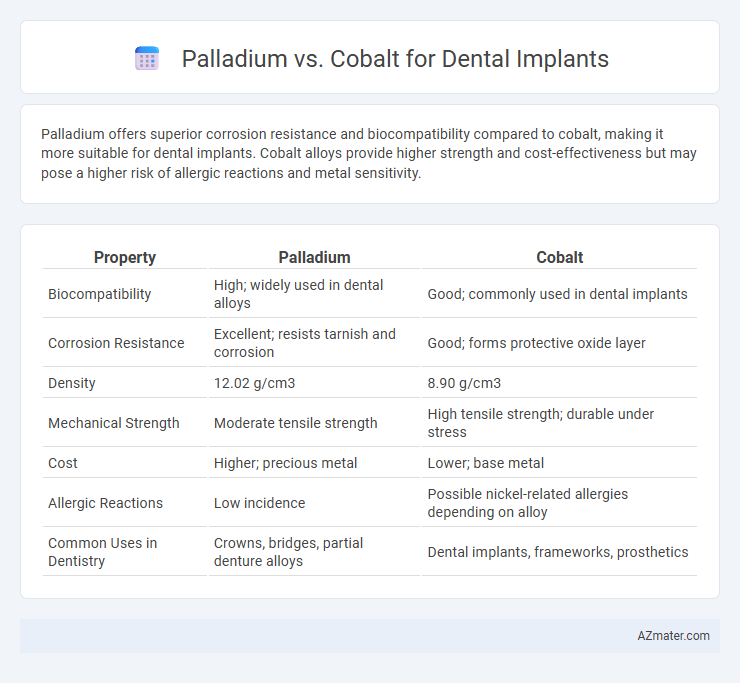Palladium offers superior corrosion resistance and biocompatibility compared to cobalt, making it more suitable for dental implants. Cobalt alloys provide higher strength and cost-effectiveness but may pose a higher risk of allergic reactions and metal sensitivity.
Table of Comparison
| Property | Palladium | Cobalt |
|---|---|---|
| Biocompatibility | High; widely used in dental alloys | Good; commonly used in dental implants |
| Corrosion Resistance | Excellent; resists tarnish and corrosion | Good; forms protective oxide layer |
| Density | 12.02 g/cm3 | 8.90 g/cm3 |
| Mechanical Strength | Moderate tensile strength | High tensile strength; durable under stress |
| Cost | Higher; precious metal | Lower; base metal |
| Allergic Reactions | Low incidence | Possible nickel-related allergies depending on alloy |
| Common Uses in Dentistry | Crowns, bridges, partial denture alloys | Dental implants, frameworks, prosthetics |
Introduction to Palladium and Cobalt in Dental Implants
Palladium and cobalt are key metals used in dental implants due to their biocompatibility and strength. Palladium, a precious metal in the platinum group, offers excellent corrosion resistance and enhances alloy durability, making it a preferred choice for long-lasting dental restorations. Cobalt, a transition metal often combined with chromium, provides high strength and wear resistance, improving the mechanical performance of implant frameworks.
Chemical Properties and Biocompatibility
Palladium exhibits excellent corrosion resistance and high biocompatibility due to its stable chemical inertness, making it less likely to cause allergic reactions in dental implants. Cobalt, often alloyed with chromium and molybdenum, offers superior mechanical strength and wear resistance but has higher ion release potential, which may lead to biocompatibility concerns. The choice between palladium and cobalt in dental implants depends on balancing chemical stability and biological tolerance to ensure implant longevity and patient safety.
Strength and Durability Comparison
Palladium offers superior corrosion resistance and biocompatibility compared to cobalt, making it a reliable choice for long-term dental implants. Cobalt alloys provide excellent strength and wear resistance but may be more prone to corrosion and allergic reactions over time. The combination of palladium's durability and cobalt's mechanical strength must be evaluated based on patient-specific needs for optimal implant performance.
Corrosion Resistance in Oral Environment
Palladium exhibits superior corrosion resistance in the oral environment compared to cobalt, making it a preferred choice for dental implants exposed to saliva and varying pH levels. The noble metal properties of palladium reduce the risk of ion release and subsequent inflammation or allergic reactions in patients. Cobalt, although strong and durable, is more susceptible to corrosion and can degrade over time, potentially compromising implant longevity and biocompatibility.
Allergic Reactions and Patient Safety
Palladium and cobalt are commonly used metals in dental implants, but palladium has a higher risk of causing allergic reactions due to its potential to trigger hypersensitivity in sensitive patients. Cobalt alloys, while durable and corrosion-resistant, can also cause allergic responses, but these occurrences are generally less frequent compared to palladium. Ensuring patient safety involves thorough allergy testing and choosing hypoallergenic materials tailored to individual sensitivities to minimize the risk of implant failure or adverse reactions.
Aesthetic Considerations: Color and Appearance
Palladium offers a bright, white-silver color that closely matches the natural shade of teeth, making it highly desirable for dental implants where aesthetic appeal is critical. Cobalt has a darker, bluish-gray hue that may be less visually compatible with natural tooth color, potentially affecting the overall appearance of dental restorations. Choosing palladium over cobalt enhances the aesthetic outcome by providing a more natural and pleasing color for implant-supported crowns and prosthetics.
Cost Analysis: Palladium vs Cobalt
Palladium dental implants typically cost significantly more than cobalt implants due to the higher price of palladium as a precious metal and its superior corrosion resistance and biocompatibility. Cobalt implants offer a more cost-effective option with adequate strength and durability, making them attractive for budget-conscious patients. The cost difference can impact the overall treatment expense, with palladium implants potentially increasing costs by 20-40% compared to cobalt-based alternatives.
Clinical Performance and Longevity
Palladium alloys in dental implants offer superior corrosion resistance and biocompatibility, reducing the risk of allergic reactions and promoting tissue integration, which enhances clinical performance. Cobalt-chromium alloys provide exceptional mechanical strength and wear resistance, making them suitable for load-bearing applications but may pose higher risks of metal ion release over time. Longevity studies indicate palladium-based implants maintain structural integrity and biostability longer, while cobalt alloys show durability but potential for late-stage hypersensitivity.
Environmental and Ethical Considerations
Palladium used in dental implants is often favored for its biocompatibility and lower environmental impact compared to cobalt, which is associated with significant ethical concerns due to cobalt mining practices often linked to child labor and unsafe working conditions. The extraction of palladium, primarily from mines in Russia and South Africa, poses environmental challenges but generally results in fewer human rights issues than cobalt sourced largely from the Democratic Republic of Congo. Choosing palladium over cobalt for dental implants supports more sustainable and ethically responsible dental care practices.
Choosing the Right Material for Dental Implants
Palladium offers superior corrosion resistance and biocompatibility compared to cobalt, making it a preferred choice for dental implants in patients with metal sensitivities. Cobalt, while cost-effective and strong, may pose higher risks of allergic reactions and lower resistance to oral environment wear. Selecting palladium can enhance implant longevity and patient comfort, especially in individuals requiring durable and hypoallergenic materials.

Infographic: Palladium vs Cobalt for Dental Implant
 azmater.com
azmater.com